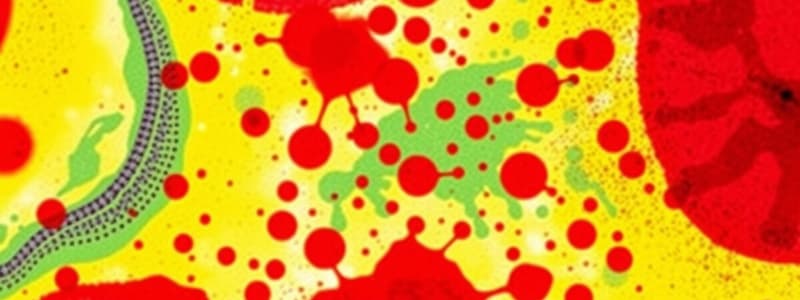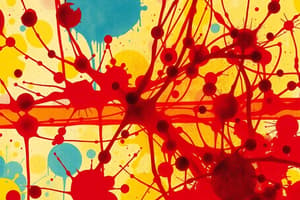Podcast
Questions and Answers
What is an accompanying drop?
What is an accompanying drop?
- A bloodstain with characteristics of a physical change.
- A small blood drop produced as a by-product of drop formation. (correct)
- The area containing intersections generated by blood stains.
- The angle at which a blood drop strikes.
What does altered stain indicate?
What does altered stain indicate?
- A bloodstain with characteristics that indicate a physical change has occurred. (correct)
- A blood drop that fell onto a surface.
- A stain caused by insect activity.
- A potential change in temperature.
What is the angle of impact?
What is the angle of impact?
The acute angle (alpha) at which a blood drop strikes a target.
Define area of convergence.
Define area of convergence.
What is the area of origin?
What is the area of origin?
What does a backspatter pattern indicate?
What does a backspatter pattern indicate?
A bloodstain is a deposit of blood on a _____
A bloodstain is a deposit of blood on a _____
What does a bloodstain pattern indicate?
What does a bloodstain pattern indicate?
A bubble ring is an outline within a bloodstain resulting from air in the blood.
A bubble ring is an outline within a bloodstain resulting from air in the blood.
A saturation stain results from the accumulation of liquid blood in an _____ material.
A saturation stain results from the accumulation of liquid blood in an _____ material.
What is a drip pattern?
What is a drip pattern?
What is the difference between forward spatter and backward spatter?
What is the difference between forward spatter and backward spatter?
Match the following bloodstain terms with their definitions:
Match the following bloodstain terms with their definitions:
What factors affect external bleeding after wounding?
What factors affect external bleeding after wounding?
What is the amount of blood in a head wound?
What is the amount of blood in a head wound?
It is possible to always know the right answer in blood spatter analysis.
It is possible to always know the right answer in blood spatter analysis.
Before attempting blood spatter analysis, what is needed?
Before attempting blood spatter analysis, what is needed?
What does a compression transfer imply?
What does a compression transfer imply?
What happens once a victim is placed into a body bag?
What happens once a victim is placed into a body bag?
A surface that is not smooth can _____ the shape of the stain.
A surface that is not smooth can _____ the shape of the stain.
Is full reconstruction of a crime scene possible?
Is full reconstruction of a crime scene possible?
How does blood dry?
How does blood dry?
Flashcards are hidden until you start studying
Study Notes
Bloodstain Patterns and Characteristics
- Accompanying drop: By-product blood drop formed during main drop creation.
- Altered stain: Bloodstain showing physical changes.
- Angle of impact: Acute angle at which blood strikes a target.
- Area of convergence: Point indicating location of blood source in two dimensions through stain intersection lines.
- Area of origin: Three-dimensional location where blood spatter originated.
Blood Patterns and Movement
- Backspatter pattern: Bloodstain pattern resulting from blood moving opposite to the applied force, often seen in entrance wounds.
- Cast-off pattern: Blood droplets released from a moving object.
- Drip pattern: Result from liquid blood dripping into another liquid.
- Flow pattern: Movement of blood across a surface due to gravity or target movement.
- Mist pattern: Blood reduced to micro-drops from high force, like a gunshot.
Bloodstain Analysis Terminology
- Parent stain: Original bloodstain from which smaller satellite stains emanate.
- Transfer stain: Bloodstain made when a blood-bearing surface contacts another surface.
- Void: An absence of blood where a barrier was present.
- Wipe pattern: Altered pattern caused by an object moving through a wet stain.
Factors Influencing Blood Loss and Patterns
- Cessation cast-off pattern: Blood released during an object's rapid stop.
- Influences on bleeding: Wound location and pressure systems (high = fast, low = slow).
- Volume correlations: Head wounds produce large blood loss; surface wounds yield small amounts.
Spatter Types and Effects
- Forward spatter vs. backward spatter: Forward travels in the wound’s direction; backward moves towards the impact source.
- Size correlation: Higher force causes smaller blood drops, while lower force yields larger drops.
- Frothy blood: Blood mixed with air, indicating lung or neck wounds.
Identification and Analysis Techniques
- Angle of impact determination: Calculated using stain length and width, applying the inverse sine function.
- Expiration patterns: Mimic spatter; less vivid and can have mucus strands.
- Patterns tell directionality: Help identify minimum blows and origin position.
Scene Reconstruction and Reporting
- Reconstructing crime scenes: Full reconstruction is often unfeasible; reports provide the most probable scenarios.
- PBA documentation: Reports must include assumptions and limitations.
- Coroner's report dependence: Essential for accurate blood spatter analysis.
Miscellaneous Facts
- Human blood volume and distribution: Average is 4-6 liters; venous system holds 58%, arterial 13%, and heart 9%.
- Surface interaction effects: Non-smooth surfaces distort bloodstains' appearance.
- Pattern formation principles: Compression transfers occur when fabric contacts blood and leaves an impression.
Drying and Transfer Properties
- Blood drying method: Blood dries from outside to inside.
- Capillary action: Blood movement follows straight pressing and lifting techniques.
- Repetitive transfers: Occur through object contact, which leads to repeated impressions.
Safety and Practical Concerns
- Identifying pattern origins: Requires the actual object that caused the pattern for correlation.
- Transfer patterns' safety: Avoid determining the source of transfer patterns due to potential contamination.
- Secondary transfers: Result from underlying layers affecting primary impressions.
Studying That Suits You
Use AI to generate personalized quizzes and flashcards to suit your learning preferences.




